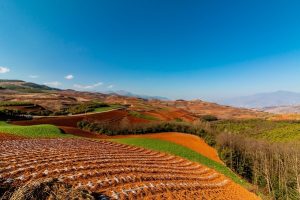
Wetlands are land cover systems that are temporarily under water for a large part of the year. According to the Ministry of Agriculture, Ethiopia’s wetlands’ coverage is approximately 25,550 km2. They are rich in biodiversity and are key land cover types for protecting and recharging shallow and deep ground water sources.
Many of the springs, rivers and ground water aquifers, which are sources of fresh water for people and livestock, are recharged by wetlands. They also help to humidify the local micro-climate. Most of the wetlands are naturally used as dry season grazing, hay production, collection of grass for thatching and mats production. Wetlands are found in various parts of the country with different topography from high mountainous regions to mid highlands and low land deserts. In addition to balancing the ecosystem and the environment, they have socio economic values for human beings. Lakes, ponds, river banks, ponds, streams, swamps, man -made lakes as part of wet lands can be categorized in these regard.
According to Afework Haile an expert in conserving wetlands, they are enriched by marine lives including various types of fishes which could create job opportunities in hunting, generate income, supports the effort to ensuring food and nutritional security. They also play pivotal role in containing rain water from changing in to flood and protect urban centers and infrastructures from damage in time of natural calamities. Stems of dead plants and sediment materials inside the water also play crucial role in sequestrating carbon from the atmosphere which triggers climate change and global warming and purifying the water.
Despite these benefits and in the absence of regulatory mechanism on their use, they are under severe threat being rapidly converted to farmlands leading to the destruction of their delicate hydrograph and loss of biodiversity values.
The wetlands of Chefa, Lake Tana and the Rift Valley can be cited, as examples of such conversion to cultivated land neither without any consideration of the damage to be inflicted on the ecosystem nor without any management plan and much of the wetland is converted into built-up areas and industrial sites.
The consequences of wetland conversion into farmlands, built-up areas and other land use systems may not be felt immediately, except for flood hazards. However, the mid- and long-term impacts will be devastating, as the response will be felt through fresh water shortages for domestic use and livestock in different parts of the country and loss of biodiversity, particularly birds. The degradation of wetland resources has significant negative impact on the socio-economic development and environmental wellbeing of the country which needs urgent and comprehensive response.
As to Afework, lack of awareness about the multifaceted services provided by wetlands, insufficient understanding on the interaction of wetland ecosystems with other ecosystems, the competing and conflicting interest of different sectors with regard to wetlands and absence of lead agency that play facilitation and coordination role to harmonize and set regulations for better management of wetlands are some of the issues that need to be addressed for maintaining the integrity of Ethiopian wetlands.
The other thing that should be mentioned is nutrient loading fertilizers such as nitrogen and phosphorous chemicals from agriculture. The industrial farms in the Awash valley extensively practiced utilizing huge amount of fertilizers as an input and in the rain season water drained from the farm find its way to the river Awash.
During the last half a century a number of wet lands in Ethiopia were proved to have been used unwisely by local communities. As the result, many of them are endangered and a few of them are on the verge of extinction.
Lake Haromaya in the Eastern Harergehe zone can be mentioned as a case in point. It is remembered that a decade and a half ago in the surrounding areas of the lake, farmers used to take water from Lake Haromaya through 250 pumps for watering farms. The amount of water they draw from the lake exceeded the inflow to the lake by natural phenomena which ended up draining the entire lake. But after successive conservation works in the catchment areas for a decade restoring the water could be realized and the ecosystem has been rebalanced again.
The expansion of urbanization and agriculture in the suburbs of wetlands also had its own impact on water bodies and the rift valley lakes region is highly vulnerable.
Over fishing also negatively contributes for imbalance of marine life in wetlands. The clearance of vegetation cover for the expansion of farm lands in the riparian areas creates havoc by letting the water bodies to be filled with delta through soil erosion. Seasonal farming in the swampy areas also made the wet lands to dry up. Currently several institutions have a stake on wetlands. The Ministry of Agriculture, the Ministry of Water and Energy and the Investment Authority have their own stake but perceive the wetland resources by their own perspectives. Some institutions show their concern with the protection of the wetlands water while others have interest on their contribution to maximized agricultural productivity and others stress on their recreational values. From these perspectives we can understand that there is a divergent interest between stake holders. This in turn has its own demerit on the protection of wetlands. When one institute provide license to investor to open industrial farm which utilize chemicals and pesticides in the nearby areas of wetlands, the other institute without awareness of the matter inspect and charge the industry owner for overriding the environment protection law and such a situation indicates that there is gap in their interconnection regarding their operation.
To bridge the gap recently pertinent government and nongovernmental institutions proposed draft law to be ratified by the federal parliament and hopefully will be endorsed soon.
As mentioned above the conservation of wetlands helps balancing the ecosystem and the environment which is a back bone of the agricultural sector. The clearance of the vegetation cover and the implementation of poorly studied development projects critically endanger wetlands. The removal of vegetation cover paves the way for flooding during the rainy season. The water which should percolate in to underground water flow rapidly towards swampy areas with no abatement due to the absence of vegetation cover.
The declining and drying up of water sources further aggravates the expansion of desertification, climate change and global warming.
As the result, agricultural productivity will be reduced consequently aggravates the already existing rural poverty. The sector is subsistence and the land degradation and the clearance of vegetation cover coupled with population growth complicated the matter.
The dwindling of water sources in streams and ponds create good opportunities for the emergence of invasive plants which could destroy crop and marine specious and jeopardize the fragile ecosystem.
Therefore, to avert the situation precautionary measures should be taken and among others, raising awareness of local communities and executive organs at the regional and the woreda level is essential.
Assessing and examining the status of wet lands and providing objective information to the pertinent stake holders regarding the utilization of the resource so that correct decision can be reached. Applying appropriate technology for the utilization of the resource sustainably is also advisable.
As mentioned above, wetlands are playing crucial role in balancing the ecosystem but the reckless utilization is shortening their life.
As they are the mouth of rivers, if they are threatened by nature or human activities the rivers existence will be at risk. In this regard their contribution is greater than the forests.
Swampy areas are enriched by grass which can be used as animal fodder and in the dry season they serve as grazing field for domestic and wild animal. More and more, they serve as tourism destiny and helps for income generation for government and local communities.
As to Afework, the effect of natural factors witnessed in wet lands such as hydro meteorology, sedimentation and seismic process is difficult to quantify because there is no monitoring mechanism hence, through conducting study and research and applying cutting age technology forwarding solutions is essential.
BY ABEBE WOLDEGIORGIS
THE ETHIOPIAN HERALD TUESDAY 11 FEBRUARY





